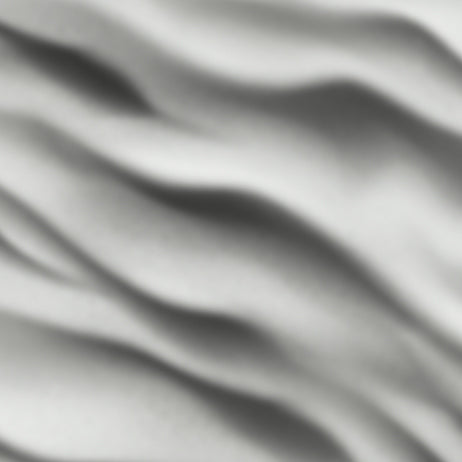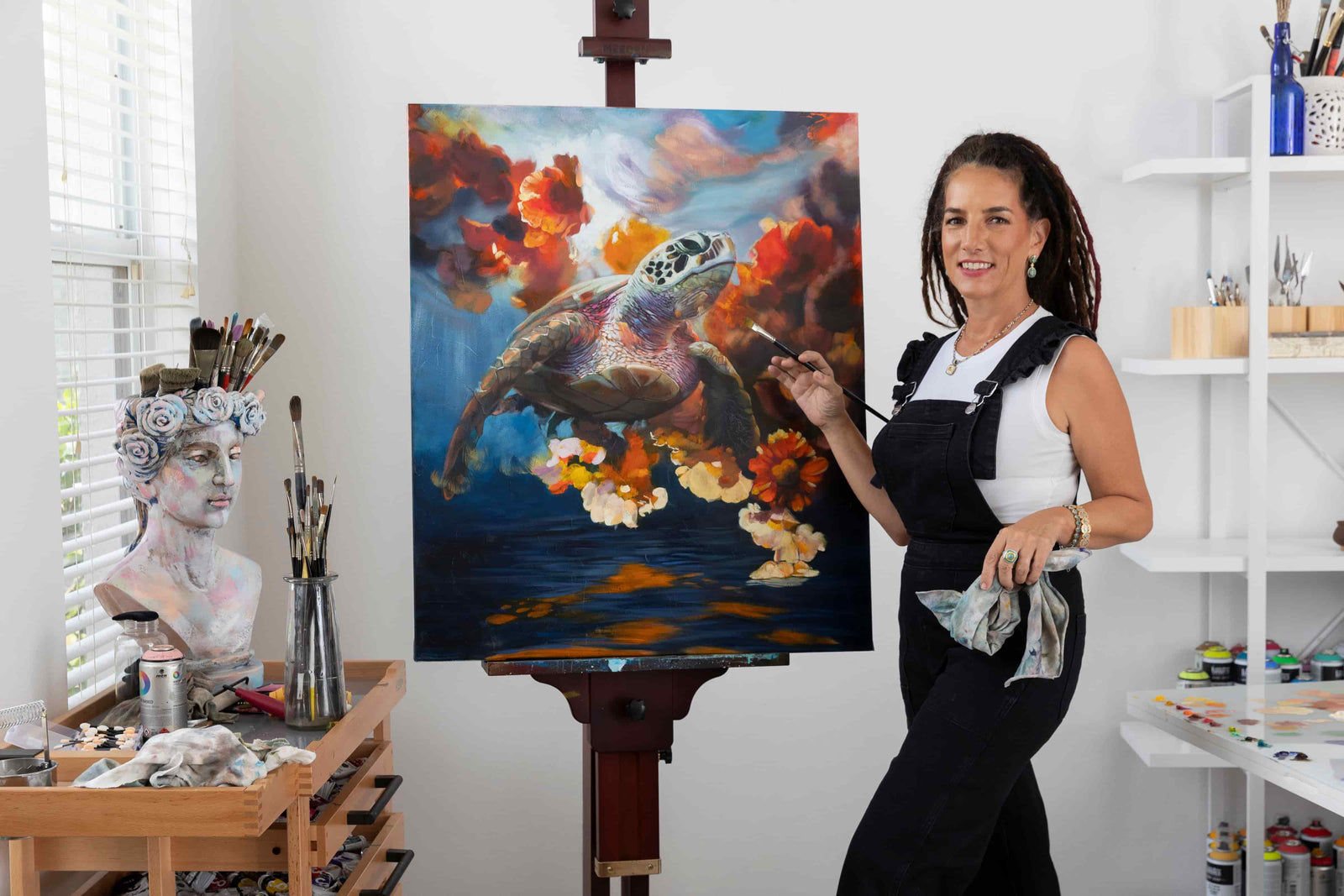How I Discovered the Surprising Secret to a Successful Art Career

It’s 1998, I’m 25 years old, and I have already achieved my dream of becoming a professional artist. I never thought it would happen this fast. I’m actually shocked to live the life I’m living.
My dad has been proven wrong. I married an artist, not an engineer, and we are not living in the streets. We are not begging for food, washing dishes, or digging ditches as he warned my entire life. We are both professional artists and fully paying our bills, with even a little left over completely on the sale of our artwork.
When I became free of my art job in Atlanta and started working with Gary, my art rep, from my home studio, John got inspired. He didn't like commuting to Atlanta alone, and he didn't like working for his art company, Del Jou Art Group. He saw that I got to sleep in a little, while he woke up in the dark to face the brutal two-hour commute to Atlanta. I was making quite a bit more money than he was, and I got to be my own boss.
Del Jou Art Group was owned by five Iranian brothers who ruled with intimidation and authority. Luckily, John was only an assistant to another artist, so he didn't have to sign any contracts. The main artists were not allowed to make any other art outside of the company, and any art they made while working for the company was “owned” by the company.
This meant they could not create or sell any art under that name or that looked anything like that art. So all of the artists working for Del Jou created aliases and signed a pseudonym to their art. The company was very protective of what was produced under their roof.
John created artwork on the side, at home in my studio, and I would give it to Gary. Gary added John’s pieces to his inventory and started to sell them. For the first time, we were able to save money and prepare for John’s freedom.
John tried a lot of different looks inspired by the modern masters: Leger, Miro, Picasso, and Matisse. He created figurative work and didn’t really hit on anything big, until he started painting cubist-style chefs. Gary started selling his chefs every week, and John was able to replace his income from Del Jou.
A Whole New Market

Now we were both free, creating from our home studios and giving Gary 10-15 paintings a week combined. Gary would sell 4-8 paintings a week for us, but his inventory was stacking up, and he told us to slow down. We could have just taken it easy and worked 10-15 hours a week, but we thought we could take on another art rep. So we talked to Gary about it.
“You should go talk to a man named Paul Robinson. He’s a dealer in Atlanta that sells more traditional art than me and serves a different clientele, so there wouldn't really be any competition. You guys have a lot of diverse skill between you, so I think it could work.”
Even though there was a lot of healthy competition in the Atlanta area and many galleries and artists knew each other, Gary was a solid, honest guy who truly wanted artists to succeed, so we took him at his word.
We brought some samples of our artwork to our appointment with Paul Robinson and set them out in front of him to look at. We are standing in the middle of his showroom in the front of a giant warehouse full of art and frames.
I look around and see a ton of landscapes, seascapes, and Tuscan houses perched on rolling hillsides inside of dark wood or gold traditional frames. This art was totally different from anything I was painting. Gary sold much more contemporary art. I don't think I had ever painted an impressionist landscape and wasn't sure I even knew how.
Paul Robinson was a Southern gentlemen with a thick Gone with the Wind accent. He talked about himself in third person.
“Robinson isn’t quite sure about this art he’s looking at,” he tells us. “Robinson likes sweet birds and fields of flowers. Robinson likes red roof houses. Cathy, we can't sell this art, can we?”
Cathy was Paul Robinson’s loyal assistant that followed him around with a clipboard. She was the entire nucleus of the operation and buffered Robinson’s eccentric ways from the others.
After some time walking back and forth across the showroom floor, holding his chin, surveying the artwork. he stopped and looks at John and me as we await our fate.
“Look, I can’t sell these newfangled things you have. I have a specific market that buys an old world look from me. They are traditional folks with traditional classic homes. So you bring Robinson some art for those people, and I’ll give you two a shot.” He told us to paint on un-stretched canvas and the sizes he likes.
We said our goodbyes and hit the 85 out of Atlanta. Once we were were in the car, I said, “Well, that was exciting! I think he will work with us if we manage some traditional looks.”
“Milan’s gonna try painting some red roof houses,” John said, copying Paul Robinson’s gentil accent.
Cracking the Code

For the next month, John and I painted a mix of Tuscan landscapes with red roof houses, some lake reflections, and a few florals with “sweet birds.” We brought them to Robinson and Cathy, hoping to sell them.
“Much better! Robinson likes these. Cathy will write you a check.”
We didn't know what we would get paid, but we learned that since he was a dealer and we were like a manufacturer, that meant 10-15 percent of the retail price without the frame. He bought six medium to small paintings from us that day, and we walked out with a check for $950. I calculated that for an 18x24 we would get around $175, and for a 12x16 maybe $100.
I was happy we got in the door and happy that he bought everything we brought. These paintings took us longer than the stuff we painted for Gary, and we made a little less than we did with Gary, but I understood Robinson was further down the food chain than Gary was. Gary sold wholesale to retail clients, and we split the wholesale, which meant about 25 percent. Slowly after Mallie, my first dealer job, Gary, and now Robinson, I was starting to understand pricing and where we fit into that distribution chain.
“John, we have to learn how to paint this style faster to make it worth it,” I said in the car, holding the check.
“I know some techniques I learned at Del Jou that will help us. I can teach them for the next batch.”
John showed me an antiquating crackle texture technique he learned using roofing tar, resin, and oil paint. I hadn't painted in oils since college, so I was super excited to learn this technique. I practiced it for a few paintings until I got the hang of it. It turned my semi-lame landscapes into old world renaissance-looking paintings found in a museum. Everything had a vignetted golden glow, and the crackle finish made it all look like it was painted hundreds of years ago.
We brought a new batch to Robinson the following week, and he was thrilled.
“Robinson’s people will LOVE these! I want to buy them all!”
We sold him 12 paintings and got a check for $1800. This new relationship started looking very promising. We still worked with Gary and made him paintings when he needed more of something. It was a nice break from the landscapes.
More, Not New

John and I got faster and faster with the landscapes and started to get orders from Robinson. Every week we dropped off artwork, he would hand us a paper with descriptions and sizes of paintings: “10 8x10 red roof landscapes, 6 12x16 lake reflections, 4 18x24 flower fields, and 2 27x31 Tuscan landscapes.”
It made life easy for us. John and I would split the order, and we had guaranteed money for the week, plus Gary’s checks which he just started mailing to us. John and I had a full-on lucrative art business we could run from our home without a website or employees, and our only overhead was supplies and gas.
The painting became very challenging because of the monotony. Every week we would throw in something new or different, but Robinson wouldn't buy it. He wanted the same thing again and again.
“Robinson can't sell that,” he would say.
I just thought, “Where are all of these paintings going? Pretty soon the whole world will own a red roof house!” But that was what he sold, and he knew the secret to business. He knew what sold to the market he created. He knew how important it was to brand and stay true to what you have become known for.
Robinson had a huge warehouse full of paintings that didn't sit around. They constantly moved through into showrooms around the country. He sold everything in bulk, stretched, framed up, and ready to be hung. He wanted each artist to have a look that fit into his market and stick with it. He said, “Milans paint crackle. Robinson’s people like crackle.”
Gary wanted variety to increase his chances among the diversity of his buyers. Gary wanted paintings on paper, because that was what designers wanted for their contemporary frames.
At a young age, we were building our business, scaling, and becoming profitable. Robinson sold our paintings faster than we could paint them. He raised our prices and paid us more money per piece. We constantly fought the challenge of making MORE, not different or new.
Artists are natural entrepreneurs. Loving a challenge. Building and growing. We love change and pushing boundaries. We love to challenge status quo and evolve. The market loves SAME and MORE. It loves predictability.
The Power of a Predictable Brand

The market thrives on an artists creating the same thing in subtle variety again and again, resisting the natural flow of the creative river that winds through, turning and twisting around its obstacles and boundaries. The market craves MORE, not new. Robinson’s sales far exceeded Gary’s because we locked into giving him more of what he sold.
I am so grateful for Paul Robinson and what I learned about the art business. I also have fought my own desires and cravings to paint new. I had to learn to be disciplined and find creative joy in the process of painting, not necessarily in a variety of outcomes.
I lost myself in the pushing and pulling of paint, the rendering of form, and the satisfaction color, instead of the idea. I disciplined myself to paint for 8-10 hours straight to get an order done on time. I kept my mouth shut when someone said something I didn't like, and welcomed good critique and tips for improvement.
Many artists deem the image too sacred and look down on what the market wants. They don't see that the delivery of a brushstroke is what holds the magic, whether it forms a tree or shrub, a poppy flower, or a building’s wall. It is Van Gogh’s “Starry Night” and Monet’s “Water Lillies” that have changed the world, because hidden within each brushstroke were the desires of their soul, the quest for Beauty, and the living code for future generations.
If we resist new and different long enough to create MORE, we will see our mastery come. We will see our voice develop and shout throughout the universe. We will see our hearts shine, and we will change the world.
Have you ever had to choose between creative freedom and financial security? What did you learn from that time?







You’ve asked such a powerful question, and I’ve sat with it a little longer because I realize now — I haven’t yet lived that tension between creative freedom and financial security the way you have. I’m still at the beginning of my journey, both artistically and in business. I’m only now stepping into the unknown, learning to trust the process, and letting go of certainty in pursuit of something meaningful. I haven’t yet faced those gritty, defining challenges… but I know they’re ahead, and I’m choosing to show up for them with openness and faith. Your story gives me courage for what’s to come. Many thanks for your reply, Elli!
———
Elli Milan Art replied:
Im sure it will come. and its a good thing. The pressure to sell and thinking about what is selling is important to balance against what we want to create. Unbridled creativity usually doesn’t create much quality. But only painting for an audience will get you passionless lifeless work. Delving into the process and loving how you paint is so important
Elli, thank you for sharing this message. I have sacrificed my own art voice and style for the past 6 years creating only paint party and step by step instructional pieces that can be taught in a class. It’s an avenue of income that has been sustaining me as a part time Artist. It has stifled my own freedom and growth as an Artist. I am hungry and ready to focus on my own voice and growth. It’s time! It’s time to show my own art work and improve with my skills. 😉
———
Elli Milan Art replied:
Yes! Let’s do it!
LOL, I started reading in Robinson’s third person accent, messed with my head a bit! Very recently I decided to paint more of one particular painting with small differences and changes, so I hope this will work in my favor, painting more, not different. If majority people like a painting, I need to punt it! Thank you for teaching us your life’s lessons.
———
Elli Milan Art replied:
Yes! John and I still imitate Robinson.
Right now, as I walk this path with the Milan Art Institute, I realize that becoming a professional artist means stepping into a lot of uncertainty — especially around future financial freedom. If I’m aiming to build an income from my art, I first have to allow myself the freedom to create without knowing what the outcome will be. That feels risky… but I sense that the journey itself is shaping me, and that the growth is as important as the goal.
What’s surprised me most is how this course has become a vehicle for deep self-reflection and personal growth — something I didn’t even know I needed. The depth it reaches is genuinely life-changing.
Thank you Elli!
———
Elli Milan Art replied:
Yes. It is! But a lucrative business is 100% in your hands. Anyone who chooses to do the work and the steps will succeed financially and otherwise. I think that is low risk and liberating bc it is in your control! I’m very excited for you! 😊
Leave a comment